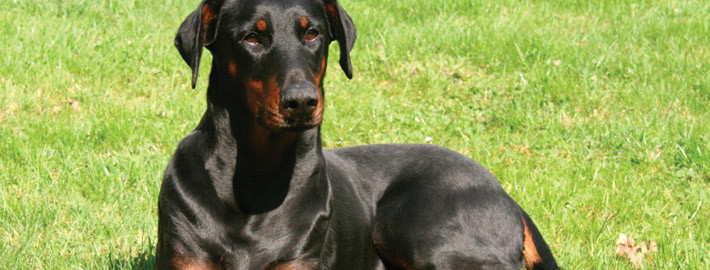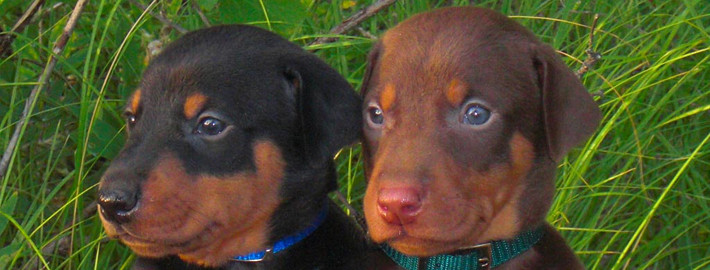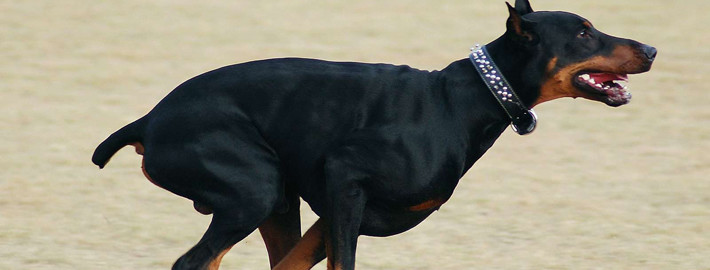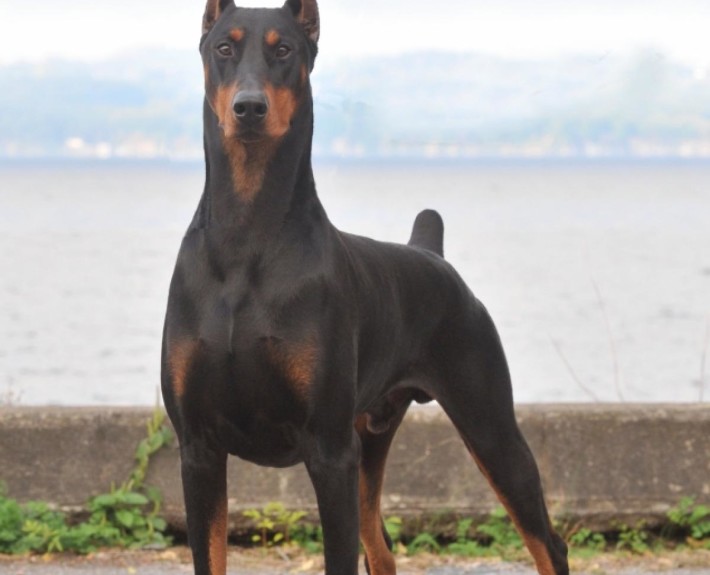What makes the Doberman Pinscher Unique?
The Doberman is compactly built, muscular, powerful and square-proportioned. It combines elegance and strength with speed and endurance. Its carriage is proud and alert, and its gait is free and vigorous. Its coat is short, smooth and hard, showing off the exceptionally clean-cut lines of this athletic breed. The Doberman pinscher is an intelligent capable guardian, ever on the alert and ready to protect its family or home. It is also a loyal and adventurous companion. It likes to be mentally challenged and is a gifted obedience pupil. It is sensitive and very responsive to its owner’s wishes, though some can be domineering. It is generally reserved with strangers. It can be aggressive with strange dogs.
Breed Groups
Page Contents
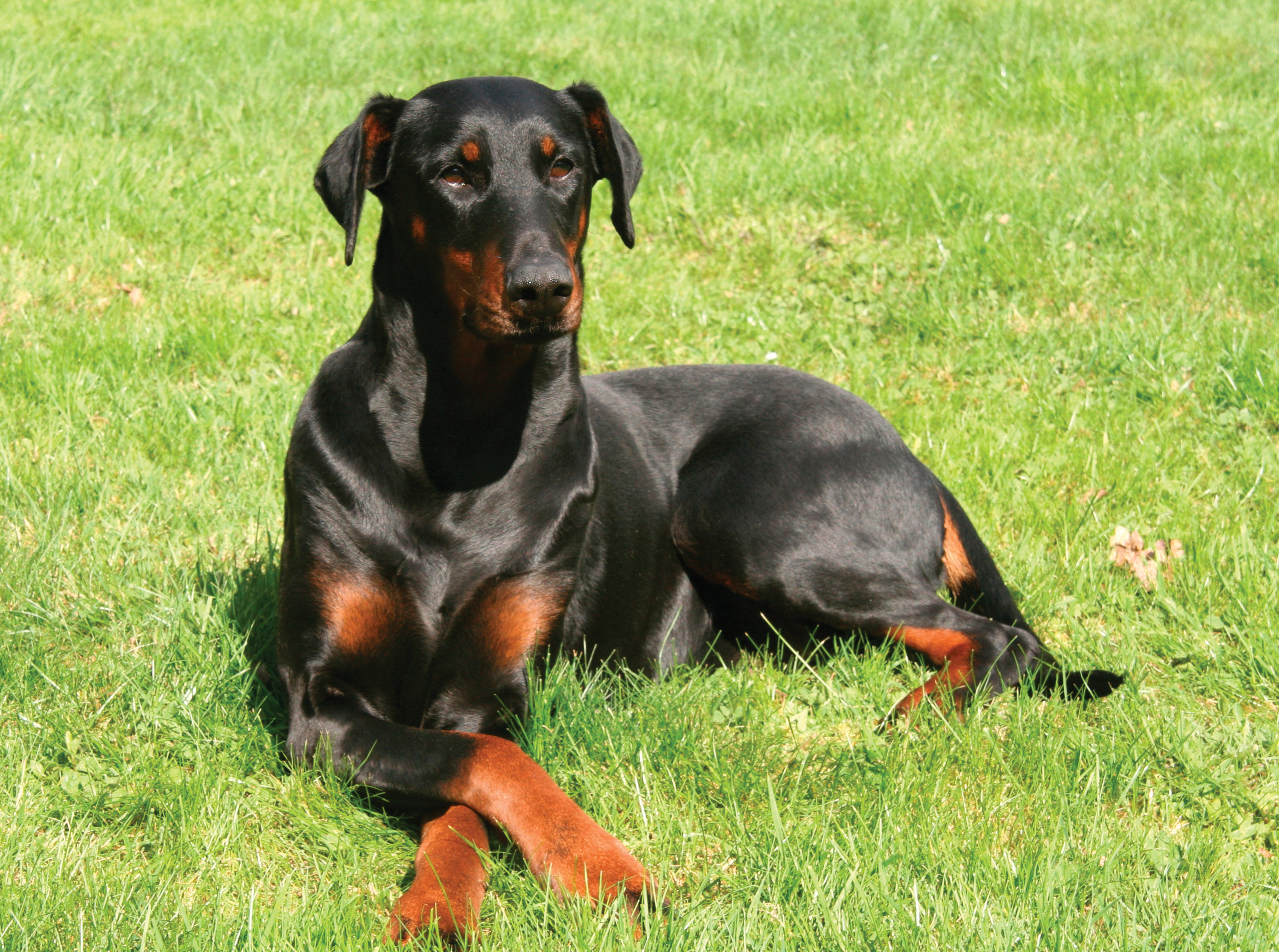
Is the Doberman Pinscher Right For You?
The Doberman is compactly built, muscular, powerful and square-proportioned. It combines elegance and strength with speed and endurance. Its carriage is proud and alert, and its gait is free and vigorous. Doberman pinscher is an intelligent capable guardian, ever on the alert and ready to protect its family or home. It is also a loyal and adventurous companion. It likes to be mentally challenged and is a gifted obedience pupil. It is sensitive and very responsive to its owner’s wishes, though some can be domineering
In 5 Words
- Alert
- Obedient
- Loyal
- Energetic
- Fearless
Characteristics
Learn About the Doberman Pinscher
Description
The Doberman Pinscher is a medium sized, squarely built dog with a compact, muscular body. The head is long and when viewed from the side, looks like a blunt wedge. The top of the skull is flat, and turns into the muzzle with a slight stop. The color of the nose depends on the color of the dog’s coat; black on black dogs, dark brown on red dogs, dark gray on blue dogs, dark tan on fawn dogs and pink on white dogs. The teeth meet in a scissors bite. The color of the almond-shaped eyes is various shades of brown, depending on the coat color of the dog. The ears are usually cropped to stand erect (cut at the age of about 12 weeks). The pup’s ears have to be taped for a couple of months to make them stand up. Its coat is short, smooth and hard, showing off the exceptionally clean-cut lines of this athletic breed. It has long, slender legs with small feet. This breed has a short, thick, glossy and hard coat. The color of the coat can be red, blue, black or fawn, may be with little rust markings.
Short History of the Doberman
In the late end of the 18th century in a town called Apolda in the province of Thueringia in East Germany, lived a man named Karl Fredrich Louis Dobermann (1834-94), after whom the Doberman was eventually named. Only a few breeds, such as the Jack Russell Terrier, the Cavalier King, Charles Spaniel, Gordon Setter, Saint Bernard, and the Keeshand, have been named after a person. The Doberman originated in Apolda, in Thueringen, Germany, in the late 1800s. It was developed by Karl Friedrich Louis Dobermann, a German tax collector who created elaborate crosses of different dogs to develop a breed that would be aggressive enough to protect him as he made his rounds in dangerous neighborhoods and whose appearance alone would be intimidating. The Doberman Pinscher emerged as a breed in Germany around the turn of the 20th century. A tax collector named Louis Dobermann, for whom the breed was named, developed the breed out of the desire for a medium-sized companion and guard dog. Taking advantage of his part-time job at an animal shelter, he used a mix of dogs—probably Rottweilers, Black and Tan Terriers and German Pinschers—to create the classic Doberman. In 1921, the Doberman Pinscher Club of America was founded, helping to promote the breed in the U.S.
Temperament
The Doberman is an intelligent, versatile dog. It is good with kids as well as other pets, including other dogs. It is an easy to train breed and very loyal to its master. However, firm authority is needed with this breed. That’s why, this breed is not recommended for beginners who cannot display the right leadership qualities for this breed. The Doberman Pinscher has strong protective instincts and thus, makes a very good watchdog as well as a guard dog. If trained well, it makes for an excellent companion breed too. This aggressive active dog always wants something to do and is a good choice for police and military service. They are uncomfortable with strangers and do not take kindly to unwanted visitors. Dobes require a dominant owner to ensure they do not become overly aggressive. They are honorable, fearless, and devoted, making fine companions. The Doberman pinscher is an intelligent capable guardian, ever on the alert and ready to protect her family or home. She is also a loyal and adventurous companion. She likes to be mentally challenged and is a gifted obedience pupil. She is sensitive and very responsive to her family’s wishes, though some can be domineering.
Caring for Your Doberman Pinscher
General Health
Von Willebrand’s Disease: An inherited blood disorder, this condition interferes with the blood’s ability to clot. The main symptom is excessive bleeding after an injury or surgery. Other symptoms include nosebleeds, bleeding gums, or bleeding in the stomach or intestines. There is no cure, and a blood transfusion from the blood of normal dogs is currently the only treatment. Most dogs with von Willebrand’s disease can lead normal lives, however. A vet can test your dog for the condition; dogs with this condition should not be bred.
Hip Dysplasia: This is an inherited condition in which the thighbone doesn’t fit snugly into the hip joint. Some dogs show pain and lameness on one or both rear legs, but others don’t display outward signs of discomfort. (X-ray screening is the most certain way to diagnose the problem.) Either way, arthritis can develop as the dog ages. Dogs with hip dysplasia should not be bred — so if you’re buying a puppy, ask the breeder for proof that the parents have been tested for hip dysplasia and are free of problems.
Progressive Retinal Atrophy (PRA): This is a family of eye diseases that involves the gradual deterioration of the retina. Early in the disease, affected dogs become night-blind; they lose sight during the day as the disease progresses. Many affected dogs adapt well to their limited or lost vision, as long as their surroundings remain the same.
Hypothyroidism: This is a disorder of the thyroid gland that’s thought to cause conditions such as epilepsy, hair loss, obesity, lethargy, dark patches on the skin, and other skin conditions. It’s treated with medication and diet.
Wobbler’s Syndrome: Suspected to be an inherited condition in Dobermans, affected dogs suffer from spinal cord compression caused by cervical vertebral instability or from a malformed spinal canal. Extreme symptoms are neck pain and paralysis of the legs. Surgical therapy is hotly debated, because in some cases the condition can recur even after such treatment.
Cardiomyopathy: This is a disease of the heart muscle, which becomes thin and weak. It’s characterized by an expansion or widening (dilatation) of the heart chambers, resulting in an abnormally large heart. This disease eventually results in heart failure, since the damaged heart muscle is too weak to efficiently pump blood to the rest of the body. Treatment varies but includes oxygen, fluid therapy, and medication that improves heart function.
Albinoism: Albinoism is a genetic condition that affects the Doberman Pinscher. An albino is not just a white dog but a dog with pink skin and nose, and blue or light eyes. Albinos are sensitive to sunlight and can suffer from a variety of health conditions, including cancer and eye problems. Albino dogs should not be bred.
Color Mutant Alopecia: This is a condition of the coat associated with blue or fawn coat colors. It affects blue and occasionally red Dobies. Most dogs who develop this condition are born with normal coats; symptoms generally start to show up at four months to three years of age. As the dog grows and matures, he develops brittle hair, followed by patchy hair loss. Only the blue portions of the coat are affected. Secondary infection and inflammation is common. The condition is incurable, although medicated shampoos may help reduce scaling and itching.
Narcolepsy: This is a neurological disorder caused by the brain’s inability to regulate wake-sleep patterns. A dog with narcolepsy may suddenly become sleepy and in fact fall asleep. Research for treatment is underway.
Gastric Dilatation-Volvulus: Also called bloat, this is a life-threatening condition that can affect large, deep-chested dogs such as Doberman Pinschers. This is especially true if they are fed one large meal a day, eat rapidly, drink large volumes of water after eating, and exercise vigorously after eating. Bloat is more common among older dogs. GDV occurs when the stomach is distended with gas or air and then twists (torsion). The dog is unable to belch or vomit to rid himself of the excess air in the stomach, and the normal return of blood to the heart is impeded.
Grooming & Bathing
Coat care is minimal. . Brushing its coat once in a week and rubbing its body occasionally with a damp towel is sufficient to maintain a healthy looking coat. Its eyes and ears need to be cleaned regularly and nail should be trimmed properly to avoid any injury.
Exercise & Training
This is an active breed that needs daily mental and physical exercise, lest she become frustrated or destructive. Her exercise requirements can be met with a long jog or walk on leash, or a strenuous run in a safe area. The Doberman is a better companion and effective guardian if she shares her human’s home.

